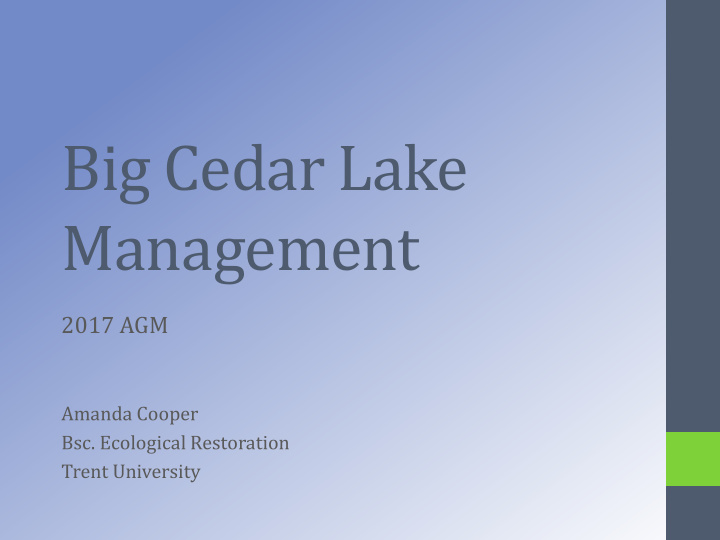



Big Cedar Lake Management 2017 AGM Amanda Cooper Bsc. Ecological Restoration Trent University
History of Management Programs Weevil Program (EnviroScience Inc. & Trent University) • Eurasian watermilfoil (EWM) weevil egg stocking Benthic Mat Program (Trent University) • Employment of biodegradable benthic mats in EWM patches • Native plant introduction EWM Monitoring (EnviroScience Inc. & Trent University) • Treatment and control sites • Initial and follow-up site surveys: plant stem density, species richness and weevil damage
History of Management Programs Year Lake Association Stocking Private Stocking Annual Total 2011 30,000 23,000 53,000 2012 35,000 27,000 62,000 2013 45,000 22,000 67,000 2014 32,800 1,000 33,800 2015 (Trent University) 25,000 0 25,000 2016 (Trent University) 40,000 0 40,000 Total 207,800 73,000 280,800 Breakdown of Milfoil Weevil egg stocking in Big Cedar Lake from 2011-2016
History of Management Programs Map of all weevil treatment sites (1 & 2), weevil + mat treatment sites (3, 4, & 5), and control sites (C) on Big Cedar Lake during 2016.
EWM Management Progress Big Cedar Lake Management Objectives: • Active management of ecological health of the lake and its surroundings (monitoring, protecting and restoring) • Preservation and improvement (or regeneration) of the environmental health of BCL • Provide information concerning matters related to the BCL community Trent’s Management Objectives: • Examine the effect of EWM weevil augmentation treatments on EWM density and species richness • Observe trends in EWM density throughout the duration of the 6- year augmentation program
2016 Results – Weevil Damage • Weevil damage increases within season but does not significantly change between years • Inter-annual changes are likely dependent on the state of EWM in each new year • High densities of weevils will not necessarily be maintained year- to-year in a patch
2016 Results – Weevil Damage Mean weevil damage in Mean weevil damage in treatment and control plots treatment and control plots during June and August 2015 during August 2015 and 2016
2016 Results – EWM Stem Density • No significant changes in EWM stem density within a season, however dramatic changes from one year to another • Collapses of EWM in treatment sites tend to occur during the winter rather than the summer • It is likely that damage inhibits the ability of EWM to overwinter • Since 2011, EWM density has declined considerably, however this appears to have plateaued which suggests a lake-scale saturation of weevils
2016 Results – EWM Stem Density 800 700 600 S1 (W2) 500 S2 S3 (W1) 400 S4 S5 old 300 S5 (W4) S6 (C4) 200 M2 100 Average 0 01-Jan-11 02-Jul-11 01-Jan-12 01-Jul-12 31-Dec-12 02-Jul-13 31-Dec-13 02-Jul-14 31-Dec-14 02-Jul-15 01-Jan-16 01-Jul-16 31-Dec-16 Historical changes in the average stem densities of M. spicatum patches in Big Cedar Lake from 2011-2016. The sites are identified by EnviroScience site codes; EnviroScience sites that overlap with the 2015 study have their new name in brackets.
2016 Results – EWM Stem Density Mean EWM stem density in Mean EWM stem density in treatment and control plots treatment and control plots during June and August 2015 during August 2015 and 2016
2016 Results – Species Richness • Despite EWM density declining in treatment sites, rapid response in native plant growth has not been apparent • Pattern of diminishing returns is likely a result of both the creation of small EWM fragments as well as the theory of natural equilibrium in biocontrol relationships
Future of BCL Management • Expand the use of vegetated benthic mats • Stocking of weevils in specific areas • Working with shoreline residents in developing a DIY program for managing EWM at their own shoreline (weed pulling and DIY installation of vegetated benthic mats) • Development of an on-going lake assessment program to monitor the lake over time
Healthy Lake Program • Initial EWM problem, however need to be mindful of and prepared for possible future threats • Necessary focus on long-term health of BCL through a broader, more comprehensive and integrated approach Main Goal: monitor and identify the appropriate approach to managing the variety of issues facing BCL now and into the future, in a sustainable and cost-effective manner Ideal Solution: acquire natural balance within the lake, as an entire ecosystem, to restore beneficial recreational areas (swimming and boating) while enhancing spawning areas (fish populations)
Healthy Lake Program Potential Future Challenge – Water Solider ( Stratiotes aloides)? • Trent River and Black River Dense mats that crowds native • vegetation Sharp serrated leaf edges • Prevent colonization through • avoiding it as an ornamental/aquarium plant, inspect boat/trailer/equipment after each use
Questions
Recommend
More recommend